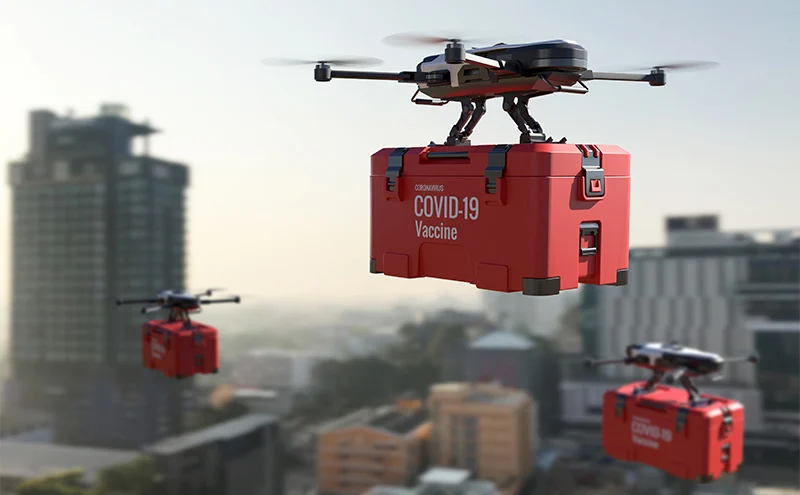The Role of Drones in Pandemic Response and Public Health
The COVID-19 pandemic highlighted the need for rapid and efficient solutions to manage public health crises. Drones have emerged as a valuable tool in pandemic response, providing contactless delivery, real-time surveillance, and public safety monitoring. Their ability to operate in remote and high-risk areas has revolutionized healthcare logistics and emergency management.
1. Medical Supply and Vaccine Delivery
Drones have been instrumental in delivering medical supplies, vaccines, and personal protective equipment (PPE) to remote and hard-to-reach locations. Unlike traditional transportation methods, drones bypass traffic congestion and geographical barriers, ensuring timely and efficient distribution of critical healthcare resources. Organizations such as Zipline have successfully deployed drone delivery systems to transport blood samples, medications, and vaccines in developing countries, improving accessibility to essential healthcare services.
2. Disinfection and Sanitization
Aerial disinfection using drones has been widely implemented in public spaces, hospitals, and transportation hubs to reduce virus transmission. Drones equipped with sprayers distribute disinfectant over large areas quickly and efficiently, minimizing human exposure to contaminated environments. This method is particularly effective in densely populated urban centers and high-risk zones where manual disinfection can be time-consuming and hazardous.
3. Public Surveillance and Crowd Management
During lockdowns and quarantines, drones have played a crucial role in monitoring public spaces and ensuring compliance with social distancing measures. Law enforcement agencies have used drones equipped with loudspeakers and thermal cameras to patrol streets, detect gatherings, and broadcast safety guidelines. This real-time surveillance capability has helped authorities respond promptly to potential health risks and maintain public safety.
4. Telemedicine and Emergency Response
Drones have facilitated telemedicine by enabling rapid communication between healthcare providers and patients in isolated areas. Equipped with high-definition cameras and communication systems, drones assist in conducting virtual consultations, diagnosing medical conditions, and delivering emergency medical kits. In disaster-stricken areas where infrastructure is compromised, drones provide a lifeline for emergency response teams by delivering first-aid supplies and assessing damage in real-time.
5. Data Collection and Disease Surveillance
Advanced drones equipped with thermal imaging, AI-driven analytics, and geospatial mapping help track disease outbreaks and monitor population health. Drones have been used to detect feverish individuals in crowds, collect air samples to analyze viral spread, and map infection hotspots. By integrating drone surveillance data with AI models, public health agencies can predict potential outbreak zones and implement preventive measures more effectively.
6. Challenges and Ethical Considerations
Despite their advantages, drone deployment in public health poses certain challenges. Privacy concerns arise due to increased surveillance, requiring strict regulations and ethical guidelines to prevent misuse. Technical limitations such as battery life, weather conditions, and payload capacity also impact drone efficiency. Additionally, ensuring proper integration with existing healthcare infrastructure remains a challenge for large-scale implementation.
Conclusion
Drones have significantly enhanced pandemic response efforts by enabling faster deliveries, improving surveillance, and supporting emergency healthcare services. Their ability to operate in challenging environments makes them a vital tool in modern public health management. As technology advances, drones are expected to play an even greater role in disaster preparedness, outbreak prevention, and global healthcare accessibility.
.png)






Leave a Comment
Your email address will not be published. Required fields are marked *